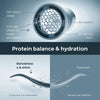
Proteins in hair repair – Balance between strength & softness
3 min reading time

3 min reading time
Learn how proteins strengthen and repair hair—but also why too much can cause damage. Balance is the key to healthy, resilient hair.
The role of proteins in hair repair – too much is also not good
Proteins are the building blocks of healthy hair—without them, hair would lose its shape, elasticity, and strength. But what many people don't realize is that too much protein can have the opposite effect: hair becomes hard, brittle, and dull. In the world of professional hair care, it's all about the right dosage and balance .
What exactly are proteins?
Proteins are large molecules made up of amino acids . In hair, they form the basis of keratin , which makes up to 90% of the hair structure.
✔ They provide strength and resilience .
✔ They repair damage caused by heat, chemicals or UV.
✔ They protect the hair fiber against breakage.
In short: without proteins there is no healthy hair architecture.
How Proteins Work in Hair Care
When hair becomes damaged, tiny holes and cracks develop in the cortex. Hydrolyzed proteins are small enough to fill these gaps.
✔ They bind to damaged areas.
✔ They strengthen disulfide bridges and keratin chains.
✔ They close the cuticle, making the hair smoother and stronger.
The most effective proteins are:
Keratin – fills structural damage.
Collagen – increases elasticity and shine.
Silk proteins – provide softness and light reflection.
Wheat or rice proteins – provide volume and strength.
The problem of protein overload
Too much of a good thing is also bad. If hair is treated too often with protein-rich products, the balance is disrupted.
❌ The hair feels hard, coarse or “straw-like”.
❌ Elasticity disappears – it breaks faster.
❌ Hydration can no longer penetrate.
The fiber is saturated and "bricked" with protein. This is called protein overload – a common problem with intensive, unbalanced diets.
The balance between protein and moisture
Healthy hair needs both strength (protein) and suppleness (hydration) .
✔ Proteins restore the structure.
✔ Hydration keeps that structure flexible.
Professional products, such as Hair Botox or Nanoplastia , combine both – they strengthen and hydrate at the same time.
When does your hair need extra proteins?
✔ After color or straightening treatments.
✔ For brittle, thin or damaged hair.
✔ After prolonged exposure to sun or salt water.
✔ If the hair loses its shape or becomes extremely brittle.
Always use proteins as part of a hydrating product rotation .
Science in balance
Research shows that hair fibers are strongest at a protein content of approximately 10–15%.
More than that offers no additional benefit – it even blocks moisture absorption. The key, then, is precision , not excess.
Conclusion: Proteins are powerful, but smart use is crucial
Proteins are the foundation of hair repair, but without balance, they become destructive. The future of hair science lies in intelligent formulas that calculate exactly what hair needs—no more, no less. Professional products work with biotechnologically measured doses to restore natural strength and shine.